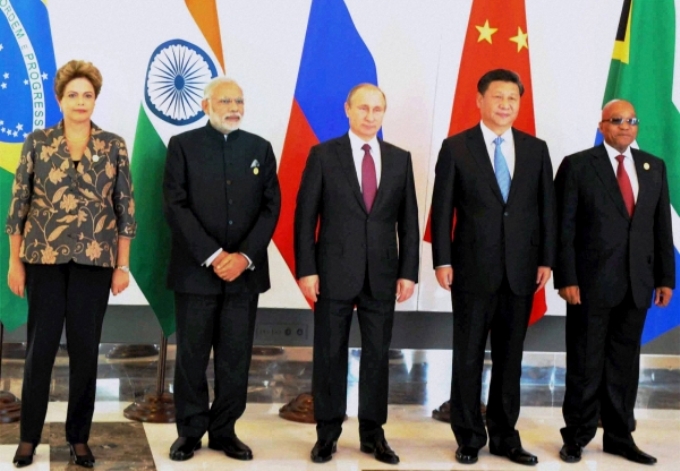Civil society groups concerned despite New Development Bank’s approval of ‘green’ first loans

The New Development Bank set up by the five-member BRICS countries – Brazil, Russia, India, China and South Africa – has earmarked its first US$ 811 million batch of loans for renewable energy projects. (Image by Press Trust of India)
Instead of funding coal plants, oil refineries or roads that cut through pristine forests as some observers had feared, new southern-led infrastructure lender the New Development Bank (NDB or BRICS bank), has earmarked its first US$ 811 million batch of loans for renewable energy projects.
The NDB this week signed-off two main disbursements of US$300 million to Brazilian national development bank BNDES and US$250 million to India’s Canara bank to enhance renewable energy capacity. Shaktikanta Das, India’s economic affairs minister, described the loans as a “good start” on the way to proving the bank’s green credentials.
South African public utility Eskom Holdings SOC Ltd and China’s Shanghai Lingang Hongbo New Energy Development Co. will receive US$180 million and US$81 million respectively. The former will construct a new transmission line and the latter is set to add 100 megawatts of rooftop solar capacity. In the case of South Africa and China, funds will be administered by public finance ministries. The locations of the projects have not been disclosed.
NDB project funding has been the subject of intrigue and concern among civil society organizations (CSOs) since the bank’s formal launch in Fortaleza, Brazil, in 2014. Yet news of these first ‘green’ loans has done little to ease their fears.
The problem, CSOs say, is that since the NDB still lacks a proper social and environmental policy framework, it cannot safeguard against the adverse impacts of its projects – no matter how green they claim to be.
“How the bank defines ‘green’ is something the bank should clarify up front before issuing any finance,” says Katherine Lu, sustainable finance coordinator at Friends of the Earth US, adding that safeguards enable banks to assess the sustainability of projects and their potential impacts on society in a consistent manner.
“Without them, banks have no moral compass,” Lu says, noting that the bank lacks staff and processes to address public feedback.
“It is a red flag that the bank remains immature as a financial institution and may not yet be ready for the international stage,” says Lu.
Starting small
While the first projects would seem to have a low environmental impact it is not clear whether NDB will continue to fund similar small-scale developments. There is nothing stipulated in the bank’s articles of agreement that rules out investment in bigger, potentially more damaging projects.
Lu doubts that these first loans are indicative of the NDB’s future funding plans since the bank’s remit is to support large infrastructure.
Caio Borges, a lawyer with Brazilian civil society group Conectas, says irrespective of a project’s size safeguards reveal a bank’s commitment to listening and incorporating communities’ perspectives into the design and implementation of a project.
“The safeguard model is the bi-product of decades of civil society struggle to ensure that development finance institutions respect, protect and fulfil human rights,” says Borges.
Kevin Gallagher of Boston University’s Global Economic Governance Initiative says that by coming out of the gate with four green projects partly financed by green bonds, the NDB has demonstrated real innovativeness.
“If the NDB can also devise state-of-the art safeguards that enhance environmental sustainability and social inclusion without dragging down the project cycle it could become a truly new model for multilateral development banking,” Gallagher says.
On-lending
By lending through member countries’ national development banks (a process known as on-lending), NDB projects become subject to the rules of these banks on managing social and environmental risks.
For Borges, this does not circumvent the need for oversight from the NDB since rules in some member countries do not align with the highest international standards on human rights, transparency and accountability.
Even with safeguards, many of the major infrastructure works financed by national development banks have failed to adequately mitigate their impacts, adds Lu, pointing to Brazil’s controversial Belo Monte dam, funded by BNDES.
Washington rules?
While the NDB seems to be doing things differently to existing multilateral development banks, the other new China-led bank in town, the Asian Infrastructure Investment Bank (AIIB), is treading a more familiar path.
The AIIB, which will invest in infrastructure to support its One Belt, One Road initiative, also approved its first loans this week. The bank will fund a highway in Pakistan, an expressway connecting Dushanbe, the Tajik capital, to the Uzbek border, and a ring road in Almaty, the capital of Kazakhstan. But in contrast to the NDB, the AIIB has incorporated safeguards into its policy framework.
The AIIB held a process of public consultation on its safeguards, which ended up more or less replicating those developed by the Washington-based finance institutions such as the World Bank. China holds a 30% vote and veto power within the AIIB. Therefore, Gallagher says, it is the NDB, in which BRICS member countries hold equal voting share, which currently offers the more interesting approach to multilateral development finance. China is also a member of the BRICS bank.
Borges points out that, for better or worse, the World Bank is seen as the reference point for safeguards. However, he says Washington-based financial institutions’ imposition of harsh ‘structural adjustment’ policies on developing countries in the 80s and 90s as a condition of lending has translated into a perception the safeguard model also undermines democratic autonomy.
All the same, Borges says, both developed and developing countries should uphold the principles to which they have committed in the international sphere.
“Safeguards play a key role in making sure that development is made to the benefit of the people and in accordance with international human rights,” he says.
